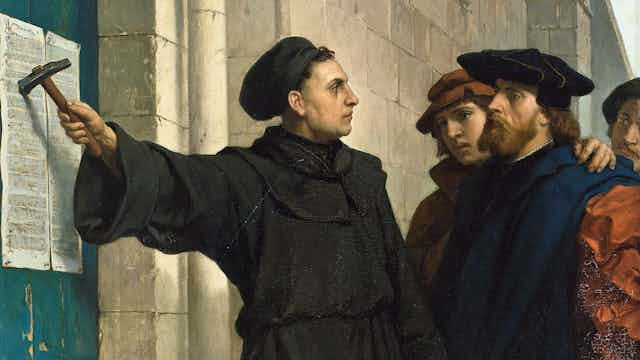The story we tell of the beginning of the Protestant Reformation 500 years ago is a window on how the past speaks to the present, and how the present imposes itself on the past.
It is a story everyone, more or less, is familiar with. On October 31, 1517, Martin Luther, a member of an obscure house of Augustinian friars in Wittenberg, went to the door of the town’s Castle Church and nailed to it a sheet containing 95 Theses. This revolutionary document, attacking corrupt teaching on indulgences and the papal authority lying behind it, was the foundational text of Protestantism. Luther’s bold action in publicising it was the starting pistol for a revolt that threw Germany into turmoil, and which soon permanently divided Europe as a whole.
To this day, Luther’s action has inspired both admiration and emulation. Perhaps the most powerful moment came on July 10 1966, when Martin Luther King Jr. marched to the door of Mayor Daley’s City Hall in Chicago and nailed up a set of demands for social and racial justice. His wife, Coretta King called it:
A magnificent, symbolic gesture that rang down the centuries from his namesake.

Myth and the man
The posting of the 95 Theses is a key moment in the popular historical consciousness. It is an irresistible meme celebrating liberty of conscience and righteous protest against the abuse of power. It is the symbolic heart of commemorations to mark “the start” of the Reformation, taking place in Germany and across the world this year.
In truth, it probably never happened. The posting of the theses was first recorded in the mid-1540s, by associates of Luther not in Wittenberg in 1517. Luther himself, in a voluminous body of often autobiographical writing, never mentioned it.
We know he sent (“posted” in the alternative sense) the Theses to the Archbishop of Mainz on October 31, 1517. But in that letter – and various others sent over subsequent months – Luther insisted the wide distribution of the Theses was none of his doing. In fact, he said that he had deliberately held back from initiating a public debate to give the authorities a chance to reform the practice of selling indulgences.

Quite possibly, later commentators assumed the Theses were posted because this was the normal procedure for initiating a disputation. It was a regular part of scholarly life, laid down in the Wittenberg University statutes of 1508. Faculty deans were to ensure that theses (discussion points) were placed in advance on the doors of all city churches. The actual posting was a chore undertaken, not by senior professors like Luther, but by low-ranking officials – most likely using wax or glue rather than nails.
It is conceivable the 95 Theses were posted, perhaps in mid-November – but if so, it was an unremarkable administrative task unlikely to have been undertaken by Luther himself. In effect, it was the 16th-century equivalent of updating a university faculty webpage.
Centenary story
It took a long time for the image of Luther hammering at the door to capture the imagination of Europeans. It first came to the fore in 1617, when beleaguered Protestants in Germany fixed on the idea of a Reformation centenary to defy a resurgent Roman Church.
But interest remained patchy: there was no attempt at a realistic visual depiction of the scene before 1697. Only in the 19th century, after the third Reformation centenary of 1817, did the event which Germans called the Thesenanschlag become a regular theme of painting, poetry and novels. It resonated perfectly with “great man” theories of history – and the prevalent notion that the Reformation was more about liberation and enlightenment than doctrinal niceties (few could remember what the 95 Theses actually said).
Historical memory in the 20th century took a darker turn. For patriotic Germans in 1917, the hammer-wielding Luther became a token of wartime struggle and defiance, and in the subsequent generation Nazis appropriated the Thesenanschlag as symbolic of the overthrow of a corrupt old order. A more wholesome, liberal version of the myth has since reasserted itself, though one still sometimes tinged with anti-Catholic stereotypes (as in the commercially successful Luther movie of 2003).
Low on memory
All this matters because the image of Luther at the door has so much shaped our view not only of when the Reformation started but of what the Reformation was. Of course, we need “events”, periods and concepts (including “the Reformation” itself) to organise our knowledge and understanding of the past. But all too easily they become timetabled stops along the fixed tramlines of historical development.
Luther in 1517 was no “Protestant”. He was a reformist Catholic friar. His theses on indulgences are in some ways surprisingly unradical, articulating the unease many thoughtful churchmen felt about the practice. Only later, through a combination of political circumstances and Luther’s own theological radicalisation, did a breach with Rome become irreparable. At no stage can it be considered “inevitable”.
Anniversaries are by definition commemorative and retrospective occasions. But we should use them to ask searching questions and interrogate old verities, not just to remind ourselves of what we think we already know.

